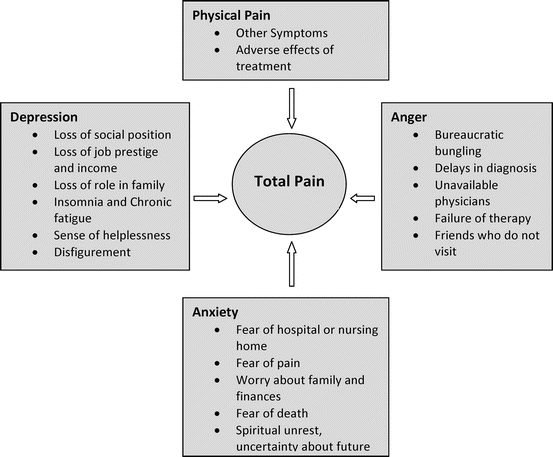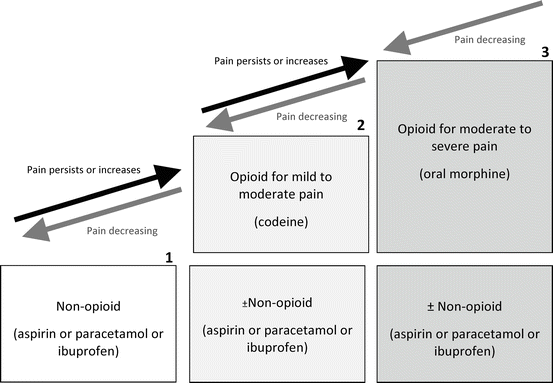Fig. 15.1
Appropriate care near the end of life (Adapted from Lynn and Adamson [34]. With permission from RAND Corporation)
Recently published research in patients with metastatic non-small cell lung cancer has shown a clear benefit to the early involvement of palliative care (soon after diagnosis) in terms of quality of life and mood. There was also a survival benefit of about 2 months compared to a group who had standard care [7], which further supports an integrated approach.
Role of Palliative Care in Urological Cancer
Palliative care has an important role in urological cancer care. This involves providing supportive care focusing on symptom control, psychological support and end of life care. A key recommendation from the National Institute for Clinical Excellence in the UK (NICE) document ‘Improving Supportive and Palliative Care for Adults with Cancer [8] is that ‘the assessment and discussion of patients’ needs for physical, psychological, social, spiritual and financial support should be undertaken at key points (such as at diagnosis; at commencement, during, and at the end of treatment; at relapse; and when death is approaching).’
UK nationally published guidance focuses on the importance of Palliative Care in urological cancer care. The 2002 NICE guidelines ‘Improving Outcomes in Urological Cancer’ state that ‘Palliative Care should be an integral part of patient management’ [9]. Furthermore, the NICE 2008 Prostate Cancer Guidelines [10] state that palliative care should not be limited to hospice care but should be integrated into coordinated care and to ensure that it is available when needed.
Another role for Palliative Care practitioners is to provide education and teaching to other professionals who may encounter patients with incurable disease in their practice. This can take to form for formal education or ‘on the job’ teaching.
Clinical Aspects
Advanced cancer of any cause is debilitating. There are numerous symptoms that patients may get and each person is affected differently. Careful assessment of the patient and their symptoms are needed in order to manage their care effectively. Some of the most common symptoms are discussed below.
Pain
Pain is a very common symptom and can affect 70–90 % of patients with advanced prostate cancer [11]. It has a profound effect on a patient’s quality of life and treatment of pain can be difficult to achieve.
Dame Cicely Saunders introduced the concept of ‘total pain’ which encompasses the physical, psychological, spiritual and social pain a patient may be experiencing (see Fig. 15.2). Not all patients will experience all of these facets of pain, however to treat one without addressing the other issues will not result in adequate control of symptoms. For example, if a patient is psychologically distressed it may be very difficult to control their physical pain until the psychological distress is established and efforts made to address it. This requires a multidisciplinary approach to care to ensure there is simultaneous focus on all the facets of pain. The multidisciplinary team may include doctors, specialist nurses, physiotherapists, occupational therapists, counsellors, social workers, psychiatrists and dieticians, as well as other allied healthcare professionals. It is also important to remember that the pain a patient has may not be related to their cancer and may be of another cause for example longstanding osteo-arthritis.


Fig. 15.2
Factors affecting patients’ perception of pain (Reprinted from O’Neill and Fallon [2]. With permission from BMJ Publishing Group Ltd)
The Pharmacological Treatment of Pain
The key to the effective pharmacological treatment is to establish the cause of the pain. This will guide the type of analgesia that will be most effective. We focus on some of the causes of pain below.
Once the cause has been established, the medication used can be tailored to the patient. Wherever possible oral analgesics should be used as first line. There will be occasions where this is not possible for example the patient is nil by mouth or too frail to manage oral medication.
Oral analgesics should be instituted using the World Health Organisation (WHO) analgesic ladder (See Fig. 15.3).


Fig. 15.3
World Health Organisation Analgesic Ladder (Adapted from World Health Organization (WHO) [35]. With permission from WHO)
The aim is to establish pain control using the simplest regime possible. Pain is a subjective experience and patients can start at any point on the ladder in accordance to the level of pain they are experiencing. Analgesia should then be titrated up or down in accordance with response to treatment and side effects. For example, if a patient is at step 2 of the ladder and their pain is not controlled they should be moved to step 3. If a patient is as step 2 and they undergo a treatment that may reduce their pain (e.g. radiotherapy to a bone metastases) it may be possible to reduce their analgesia with careful observation.
It is important to note that many patients will develop side effects from mild and strong opioids. Often these side effects can be managed effectively allowing a patient to continue taking the analgesia they need. There may be incomplete cross tolerance when starting opioids, which means that a patient may become tolerant to the side effects associated with the opioid but the analgesic effects persist, this is particularly true of opioid associated nausea. It is therefore important to warn patients of the side effects they may experience in order to increase compliance with a new medication. For example, when starting a strong opioid it is important to start a laxative at the same time as constipation occurs in almost all patients. The patient can be warned of this common side effect and advised to inform their doctor or nurse if it is becoming an issue so the laxatives may be increased. If a patient has uncontrollable or intolerable side effects with a medication it should be changed to another medication from the same class, for example opioid switching from morphine sulphate to oxycodone. However, there is little evidence that oxycodone has fewer side effects than morphine sulphate, though individual patients may tolerate one better than the other [12].
The use of adjuvants with opioid-based analgesia is an effective way of managing pain and minimising the dose of opioids needed, thereby reducing side effects. Adjuvants that may be considered include non-steroidal anti-inflammatory drugs (NSAID), corticosteroids, neuropathic pain medication and bisphosphonates, all of which have their own side effects and contraindications.
Non-pharmacological techniques may also be useful in some patients. For example, use of transcutaneous electrical nerve stimulations (TENS) or cognitive behavioural therapy (CBT). Disease modifying therapies such as chemotherapy and radiotherapy also have a role in the management of pain.
Types of Pain
Tumour Pain
The tumours themselves, primary or secondary, may be painful. They can cause pain by compressing or invading local structures including nerves. Tumour pain can be effectively managed using the WHO analgesic ladder with adjuvants such as steroids which may be useful in reducing swelling around the tumour
Bone Pain
Bone metastases are common in urological cancer. Ninety percent of patients with metastatic prostate cancer have bone metastases. This pain can be managed using the WHO analgesic ladder and adjuvants including steroids. Radiotherapy is beneficial in the majority of cases. The 2008 NICE guidelines for the treatment of prostate cancer indicate that bisphosphonates should be used treat bone pain in hormone refractory prostate cancer where analgesics and radiotherapy have failed [10]. They also advocate the use of strontium-89 [10]. If a patient develops worsening pain in a long bone related to a bone metastasis, there is a risk of an impending fracture. If the patient has an appropriate functional level they should have an x-ray and an orthopaedic review to consider prophylactic surgery. An impending fracture is more likely if the metastasis is large or peri-tronchanteric. Newer drugs e.g. Denosumab a monoclonal antibody against RANKL (the main driver of osteoclast formation) have been licenced which may have a role in prevention of skeletal events in bone metastases [13].
Neuropathic Pain
This is pain caused by compression of a nerve either by the original tumour or a metastasis, or may be due to chemotherapy induced neurotoxicity. The patient may describe shooting, burning or stinging pain. In 2010 NICE produced guidelines for the treatment of neuropathic pain. These guidelines advocate the use of amitriptyline or pregabalin as first line treatment [14].
Incident Pain
This is pain that occurs as a result of a particular event, for example mobilising or wound dressing changes. This pain is best managed using short acting analgesia. This can include the newer short acting nasal or buccal fentanyl preparations which have a quicker onset of action and a shorter duration of action [15, 16] than the older short acting opioids (e.g. oramorph and oxynorm) [17].
Metastatic Spinal Cord Compression (MSCC)
Within the UK, NICE defines MSCC as ‘spinal cord or cauda equina compression by direct pressure and/or induction of vertebral collapse or instability by metastatic spread or direct extension of malignancy that threatens or causes neurological disability’ [18]. In 2008 [18], NICE produced guidelines on the ‘diagnosis and management of adults at risk of and with MSCC’. MSCC is common and is an oncological emergency. Delay in diagnosis and treatment can cause huge morbidity and distress. It affects 1–12 % of patients with metastatic prostate cancer, though can occur in any patient with boney metastatic disease affecting the spine [19] which would include many of the urological cancers.
MSCC can present in a number of ways. The earliest symptoms are pain in the back and spinal tenderness. It can cause a number of other neurological signs and symptoms, however once these are evident the MSCC may already have been present for a period of time, which can make functional recovery less likely. Early detection and diagnosis are vital to retaining function.
In the UK, if a patient has a suspected MSCC they must be discussed with the local MSCC co-ordinater within 24 h of presentation. This is to ensure prompt assessment and treatment, which takes into account the patient’s functional level and preferences. The imaging of choice is magnetic resonance imaging, unless contraindicated, of the whole spine as there are often multiple levels of compression [18].
If a patient has suspected MSCC they should be nursed flat if there are any signs of spinal instability. High dose steroids should be initiated as soon as possible and will often precede imaging [18]. Once MSCC has been demonstrated on imaging, choice of treatment will be determined by patient preference and performance status. The options include radiotherapy or spinal surgery to decompress the spinal cord. There is strong evidence that surgery followed by radiotherapy provides a better functional outcome than radiotherapy alone. In a study of 101 patients with MSCC who were randomly assigned to radiotherapy alone or decompressive surgery followed by radiotherapy, significantly more patients were able to walk after the combined therapy (84 %) than after radiotherapy alone (54 %) [20].
< div class='tao-gold-member'>
Only gold members can continue reading. Log In or Register to continue
Stay updated, free articles. Join our Telegram channel

Full access? Get Clinical Tree







